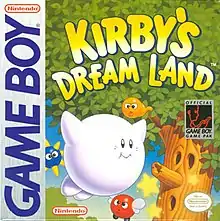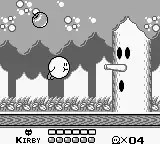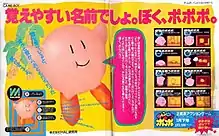Kirby's Dream Land
Kirby's Dream Land[lower-alpha 1] is a platform game developed by HAL Laboratory and published by Nintendo for the Game Boy. Released in 1992, it is the first game in the Kirby series and the debut of Kirby. It created many conventions that would appear in later games in the series.
| Kirby's Dream Land | |
|---|---|
 North American box art for the Game Boy | |
| Developer(s) | HAL Laboratory |
| Publisher(s) | Nintendo |
| Director(s) | Masahiro Sakurai |
| Producer(s) | Makoto Kanai |
| Programmer(s) | Satoru Iwata |
| Artist(s) | Masahiro Sakurai[1] |
| Composer(s) | Jun Ishikawa |
| Series | Kirby |
| Platform(s) | Game Boy |
| Release | |
| Genre(s) | Action, platformer |
| Mode(s) | Single-player |
Kirby's Dream Land was designed by Masahiro Sakurai, who intended it to be a simple game that could be easy to pick up and play by those unfamiliar with action games. For more advanced players, he offered additional optional challenges such as an unlockable hard mode and the ability to edit Kirby's maximum HP and starting number of lives. Kirby's Dream Land was re-released on the Nintendo 3DS via the Virtual Console in 2011 and is also one of the games included in the compilation game Kirby's Dream Collection for the Wii, released to celebrate Kirby's 20th anniversary.
Gameplay

Kirby's Dream Land is a side-scrolling action-platformer. Like many other platformers of the 8-bit and 16-bit era of video games, levels are played on a two-dimensional plane in which the protagonist, Kirby, can move left or right as well as jump. Kirby's main method of attack is to inhale enemies and objects into his mouth, after which the player can choose to swallow or spit them out as a star-shaped projectile attack. In addition to running and jumping, Kirby can fly by inflating himself with a mouthful of air and flapping his arms. Flying can be done indefinitely; however, while flying, Kirby's only method of attack is to release the air puff held in his mouth which cancels his flight.
The game consists of a total of five levels. Levels are made up of a series of large "rooms" connected by doors that lead Kirby to different areas, rather than the single continuous corridors typical of platformers at the time. Some of these doors lead to hidden areas or alternate pathways through the level. The doors act as checkpoints returning the player to the beginning of a "room" should they die rather than starting the level over. The goal of the game is to clear the level by defeating the boss at the end. If Kirby touches an enemy or an dangerous object, he loses one or more of his health, depending on the enemy or obstacle he touched. If all of his health is lost, or he falls into a bottomless pit, the player loses a life. Losing all lives results in a game over. Kirby can recover lost health by eating food, found across the stage.
Unlike the copy abilities of later games, Kirby's Dream Land has more traditional power-ups that offer Kirby temporary abilities when he picks them up. These often appear in the form of food, such as Spicy Curry that gives Kirby fire breath or a Mint Leaf (Sweet Potato in the Japanese version) that lets Kirby fire air puffs rapidly without losing flight. At the end of each level is a boss Kirby must fight to obtain one of the Sparkling Stars. Most bosses are fought by sucking up small objects or projectiles created by the boss' attacks and spitting them back at the boss. The third boss, Kaboola, is fought using an unlimited version of the Mint Leaf item, incorporating shoot 'em up elements. The last level before the final boss consists of a boss rush, where Kirby must fight all of the game's bosses again going through a short area based on that boss's home level.
Like many 1980s-era platformers, the player can accumulate points by defeating enemies and collecting items, with an extra life granted when the player has enough points. However, because Kirby's Dream Land lacks a save function, scores are not recorded. Also, there are no save files, so the player has to start over again when the Game Boy is turned off, if the player chooses to return to the title screen after a game over, or if the player resets the game. Once the game has been completed, a code is offered to play an optional extra game, in which the difficulty is significantly increased. Completing the extra game offered a second code that lets the player adjust lives and vitality settings to play an easier or even harder game, and listen to music and sound effects freely.
Plot
Kirby's Dream Land is set in the fictional country of Dream Land located on a tiny star-shaped planet far, far away from Earth. The Dream Landers are a very peaceful and carefree people that use their magical Sparkling Stars to play and work among the heavens.
One night, under the cover of darkness, the gluttonous King Dedede and his minions swoop down from his castle on Mt. Dedede and steal all the food in Dream Land as well as the Sparkling Stars used to obtain more food. The next morning as the residents are discussing what to do, a spry little boy named Kirby, steps forward and volunteers to retrieve the food and stars, and stop Dedede.
Development

Kirby's Dream Land was developed by Masahiro Sakurai of HAL Laboratory. Kirby initially was a dummy character that the developers used until they could define a more sophisticated image. However the designers grew to like Kirby so much that they decided to keep him instead of using a more advanced character. At the time he was to be named Popopo (ポポポ), and Kirby's Dream Land was titled Twinkle Popo (ティンクル・ポポ, Tinkuru Popo). Eventually, he was renamed Kirby and the game was renamed Hoshi no Kirby; Kirby of the Stars, also the name of the Japanese version of the Kirby anime. During the development of what was referred to as Twinkle Popopo, Popopo/Kirby's color had not been decided upon. Sakurai wanted him to be pink, while Shigeru Miyamoto felt that he should be yellow. Eventually, Nintendo decided to make him pink. Although pink is still Kirby's main color, later games have used a yellow Kirby to represent the second player in multiplayer. When Kirby of the Stars was released in Japan, it featured Kirby as being pink. However, Nintendo of America designed the North American box art and advertisements with a white Kirby based on the game's grey-scale visuals.[2]
The music was composed by Jun Ishikawa.[3] He has been a regular composer in the Kirby series. His most recent work was on Kirby: Star Allies in 2018. Certain songs were also reused in the Super Smash Bros. series as the background music of the Dream Land stage in Super Smash Bros.[4] and the Green Greens stage in Super Smash Bros. Melee.[5]
Reception
Kirby's Dream Land has received generally positive reception. It holds an aggregate score of 62% on GameRankings with nine reviews, making it the 17th best Game Boy game.[6] By May 28, 1994 Kirby's Dream Land sold 1.3 million copies.[8] To date, it has sold in excess of 5 million copies worldwide; Gamasutra cited its new style of gameplay for its success. At the time, it was HAL Laboratory's most successful game.[9] Gamasutra's Osamu Inoue attributed the game's success to Satoru Iwata, formerly an employee of HAL Laboratory, who Inoue comments has a "simple-minded passion for creating games".[9] Game Informer's Ben Reeves called it the 14th best Game Boy game and felt that it was a relaxing game.[10] Author Wendy Despain used Kirby's Dream Land's plot as an example of how early platform games' plots progressed, which she collectively described as "the main character needing to reach a villain to put right a wrong."[11] Humongous Life's Jonathan Wahlgren called it a strong game, but felt it to be "too elementary".[12] GamesRadar's Brett Elston did an article on its music, specifically giving praise to the final boss music, stating that it is the "only song in the original Kirby that had a sense of challenge or conflict instead of skipping through a field of floating cakes."[13] Nadia Oxford of 1UP.com praised it for its unique platforming mechanics, describing it as the start of a "gluttonous legend".[14] Allgame's Joshua Crystal called it a "great game for beginner players and ones that enjoy a fun, but short, experience."[15]
In an article detailing various Kirby series video games, IGN stated that it was a decent platformer, but basic compared to later games.[16] IGN's Lucas M. Thomas and Craig Harris included Kirby's Dream Land in their wishlist for a hypothetical "Virtual Console" for the Nintendo 3DS, commenting that its inclusion would be based on nostalgia rather than it feeling "new and sensational". They also added that original characters like Kirby were the stars of the Game Boy rather than established characters such as Link, Mario, Samus Aran, and Pit.[17] They would again praise Kirby's Dream Land for being an original game in their "History of the Game Boy" article, adding that while "attitude" was common in new platforming mascots, Kirby was cheery and adorable, while the game featured "breezy, casual gameplay and lighthearted atmosphere".[18] GameSpy's Gerald Villoria, Brian Altano, and Ryan Scott called it "basic" compared to later games in the series, adding that it lacked a sense of danger because Kirby could fly.[19] Nintendo Power editors George and Bob shared roughly similar opinions of the game; George stated that it is a really fun game, owing its quality to its excellent play control and well thought out concept, while Bob stated that it is deceptively simple looking, when it in fact features a decent challenge for more experienced gamers.[20] GamesRadar listed Kirby's Dream Land and its sequel as two of the games they want in the 3DS Virtual Console.[21]
Sequels
Kirby's Dream Land has spawned numerous of sequels across several video game consoles. The first direct sequel, Kirby's Adventure, released on the Nintendo Entertainment System, introduced the ability to steal powers from enemies, an ability which would become a staple of the series following it.[22] The series has featured several spin-offs, in differing genres including a racing game Kirby Air Ride, pinball game Kirby's Pinball Land, and an action-golf hybrid game Kirby's Dream Course.[23][24] Kirby's Dream Land would receive a Game Boy sequel in 1994 Kirby's Dream Land 2, which incorporated the copy mechanic from Kirby's Adventure.[25][26]
The Super NES game Kirby Super Star contains a shortened remake of Kirby's Dream Land, "Spring Breeze". It features Kirby's copy ability from later games and the ability to summon helpers for co-op, but is missing the Castle Lololo stage and Kaboola boss fight, Lololo and Lalala becoming the boss for Float Island instead. Kirby Super Star Ultra expanded upon this with "Revenge of The King", a harder version of "Spring Breeze" that takes heavy inspiration from Kirby's Dream Land's extra mode and features longer levels more in line with the original game. Although Castle Lololo is still absent, Kaboola's boss fight returns in a reimagined form.
Kirby and King Dedede appear as playable characters in the fighting game series Super Smash Bros.. Both characters have alternate costumes that give them a monochrome appearance reminiscent of the Game Boy's graphics. The "Green Greens" stage, first appearing in Super Smash Bros Melee is based on this game's first level.[27] The "Dream Land GB" stage, introduced in Super Smash Bros. for Nintendo 3DS, transitions between multiple locations from Kirby's Dream Land as displayed through a monochromatic Game Boy screen.[28]
Notes
- Known in Japan as Hoshi no Kābī (星のカービィ, Kirby of the Stars)
References
- "桜井政博氏が語る、初代『星のカービィ』開発秘話。当時の企画書に、あのゲームの原点があった?". ファミ通.com (in Japanese). Archived from the original on December 20, 2018. Retrieved December 5, 2018.
- "Welcome to Kirby's Rainbow Resort! - Creation". GameSpy.com. Archived from the original on April 14, 2009. Retrieved March 6, 2007.
- "Kirby's Dream Land for Game Boy - MobyGames". MobyGames.com. Archived from the original on January 23, 2013. Retrieved June 24, 2007.
- "Kirby Series". NinDB. Archived from the original on June 19, 2010. Retrieved January 9, 2008.
- "Super Smash Bros. Melee Orchestra OST". phdreams.com. Archived from the original on July 16, 2006. Retrieved March 17, 2007.
- "Kirby's Dream Land for Game Boy". GameRankings. Archived from the original on January 23, 2013. Retrieved October 9, 2010.
- Crystal, Joshua. "Kirby's Dream Land - Review". Allgame. Archived from the original on December 12, 2014. Retrieved December 11, 2014.
- "Atlanta News, Sports, Atlanta Weather, Business News | ajc.com". Nl.newsbank.com. May 28, 1995. Archived from the original on October 23, 2012. Retrieved October 9, 2010.
- "Features - Iwata and Miyamoto: Business Ascetics - An Excerpt from Humoungous". Gamasutra. Archived from the original on January 23, 2013. Retrieved October 9, 2010.
- Reeves, Ben (June 24, 2011). "The 25 Best Game Boy Games Of All Time". Game Informer. Archived from the original on January 11, 2018. Retrieved December 6, 2013.
- Despain, Wendy (February 26, 2009). Writing for video game genres: from ... - Google Books. ISBN 9781568814179. Archived from the original on January 4, 2014. Retrieved October 9, 2010.
- "Kirby's Dream Land (Retro) review". Retro.humongous.com. August 3, 2009. Archived from the original on January 23, 2013. Retrieved October 9, 2010.
- "Game music of the day: Kirby's Dream Land". GamesRadar. June 21, 2010. Archived from the original on January 23, 2013. Retrieved October 9, 2010.
- "Complete History of Kirby". 1up.com. Archived from the original on January 23, 2013. Retrieved October 9, 2010.
- Crystal, Joshua (October 3, 2010). "Kirby's Dream Land - Review". allgame. Archived from the original on December 12, 2014. Retrieved October 9, 2010.
- "Kirby Compared". IGN. September 26, 2008. Archived from the original on October 1, 2008. Retrieved October 1, 2008.
- Thomas, Lucas M. (August 17, 2009). "The DSi Virtual Console Wishlist - DS Feature at IGN". Ds.ign.com. Archived from the original on December 11, 2010. Retrieved October 9, 2010.
- Fahs, Travis (July 7, 2010). "IGN Presents the History of Game Boy - Retro Feature at IGN". Retro.ign.com. Archived from the original on May 28, 2010. Retrieved October 9, 2010.
- "GameSpy: Game Boy 20th Anniversary Celebration, Day 1: Then and Now - Page 1". Ds.gamespy.com. Archived from the original on January 23, 2013. Retrieved October 9, 2010.
- "Nintendo Power". GameSpy.com. Archived from the original on February 15, 2008. Retrieved March 26, 2007.
- "12 classic Game Boy and Game Boy Color games we want on 3DS". GamesRadar. January 19, 2010. Archived from the original on September 30, 2012. Retrieved January 27, 2011.
- "27. Kirby's Adventure - Top 100 NES Games". IGN. Archived from the original on January 23, 2013. Retrieved August 30, 2013.
- "Kirby Air Ride - GameCube - IGN". Cube.ign.com. March 4, 2004. Archived from the original on November 5, 2010. Retrieved August 30, 2013.
- "Kirby's Pinball Land - Game Boy - IGN". Gameboy.ign.com. Archived from the original on June 13, 2011. Retrieved August 30, 2013.
- "Kirby's Dream Land 2 for Game Boy from". 1UP. Archived from the original on March 26, 2009. Retrieved August 30, 2013.
- "Kirby's Dream Land 3 - Wii - IGN". Wii.ign.com. January 5, 2009. Archived from the original on March 7, 2012. Retrieved August 30, 2013.
- "Super Smash Bros. Melee - cube - Walkthrough and Guide - Page 34 - GameSpy". Cube.gamespy.com. January 20, 2002. Archived from the original on January 23, 2013. Retrieved August 30, 2013.
- "Archived copy". Archived from the original on September 23, 2020. Retrieved August 19, 2020.CS1 maint: archived copy as title (link)
